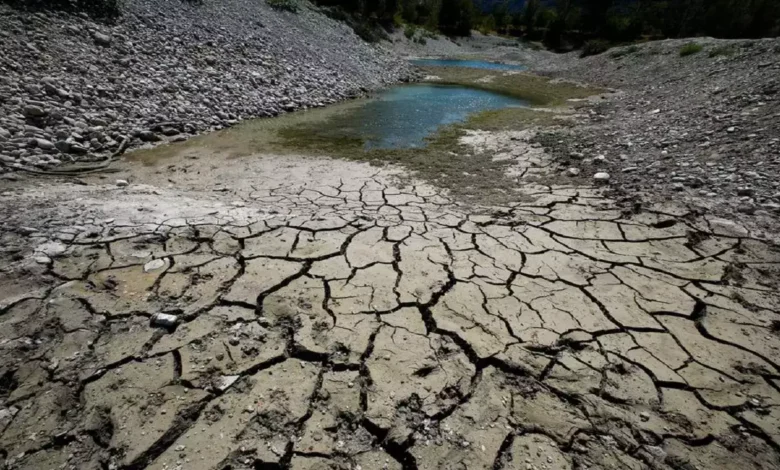River dries up to expose unexploded WWII bomb in Italy as Europe faces worst drought in 500 years
As per a latest report by Global Drought Observatory, the soil dried up across 47% of the continent (warning levels) while 17% is on alert with the vegetation showing signs of stress.

You must have seen dramatic pictures and videos from across Europe on the Internet, of rivers reduced to shallow streams, boats trapped in dried-out shores, and artefacts and even bombs from the World War II emerging from riverbeds as water levels fall in Europe as it faces its most severe drought in over 500 years.
As per a latest report from the Global Drought Observatory (GDO), almost 2/3rds of Europe is at risk of extremely dry conditions and drought with the soil dried up across 47% of the continent (warning levels) while 17% is on alert with the vegetation showing signs of stress.
This has been triggered by a lack of precipitation in the continent since the start of this year which worsened after the heatwaves began in May expanding the drought situation. This was caused by the general atmospheric circulation pattern in the late spring/early summer in Europe persisting further into the summer. This pattern is typically associated to both heat waves and drought during the summer months in Europe, as they tend to steer away from the continent’s weather systems that bring in moist and cool air.
As a consequence, drought hazard has been increasing, especially in Italy, Spain, Portugal, France, Germany, the Netherlands, Belgium, Luxembourg, Romania, Hungary, northern Serbia, Ukraine, Moldova, Ireland and United Kingdom. The rest of Europe, already affected by drought, maintains stable severely dry conditions.
Regions that were already affected by drought in Spring 2022 (e.g., northern Italy, south-eastern France, some areas in Hungary and Romania), are the ones with the most worsening conditions.
The GDO report has warned that the dry spell will hit crop yields, spark wildfires, and may last for several months more in some of Europe’s southern regions.
Impacts of the Drought in Europe:
Rivers and Lakes: With an obvious impact on rivers and lakes drying up, boats have remained stranded on shores and riverbeds have revealed forgotten artefacts from the past. “Hunger stones” that have propped up along the river Rhine bring with them an echo and reminder of the struggles people endured during previous droughts.
The river Danube, dropped to one of its lowest levels in nearly a century, exposing the wrecks of more than 20 German warships that were sunk during World War II close to Serbia’s river port city of Prahovo.
In Italy, from underneath the low-running waters of Italy’s longest river, a World War II bomb weighing 450 kg (1,000 pounds) that had been previously submerged was found.
Meanwhile, with the dipping water levels in Europe’s water bodies, water resource management is critical.
Electricity: In midst of an already escalating global energy crisis, the drought has further put pressure on Europe’s power supply. According to the report, hydroelectric power production has decreased by a considerable 20% in the continent. The drought has also impacted cooling systems of other power plants.
Crop Yields: The exceptional water and heat stress has substantially reduced yields of the continent’s main crops. The EU yield forecasts for reductions in yield are the most for grain maize, soybean, and sunflowers at -16%, -15%, -12% respectively wrt the last 5 years average yield.
Economic impact: The drought has not only affected Europe environmentally but also commercially with the shipping delays on its major shipping artery the river Rhine. The Rhine flows through Germany’s industrial heartland, from the Swiss Alps to the North Sea transporting everything from grains, to chemicals and coal. However, in the current situation, its waters have dropped to such low levels, that less freight can be transported, leading to delays and higher costs.
Boats have been loaded to only 30-40% capacity to avoid running aground. The disruption could impact the country’s economic growth by as much as .5%, which is substantial in the bigger picture according to economists.
Over the years, brought on by excessive burning of fossil fuels, heat waves have increased in intensity and frequency all over the world, also including India. Repercussions of the same are now being witnessed by Europe.
Since the industrial revolution, the average global temperature has increased by 1° Celsius. As tiny and insignificant as this variation may look, on an average, the yearly global temperature has driven up extreme temperatures to an absurd level.
Apart from this, changing weather patterns, dry soil, climate change, oceanic and atmospheric circulation are also responsible for this extreme weather phenomenon.



